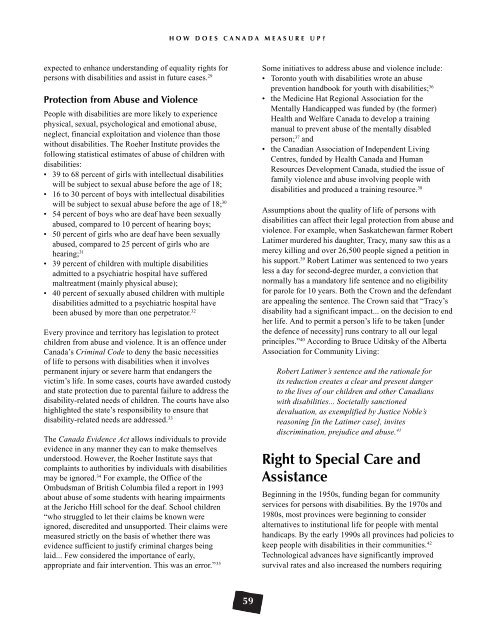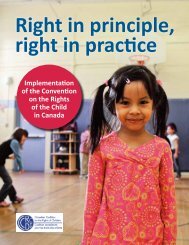Poste - Canadian Coalition for the Rights of Children
Poste - Canadian Coalition for the Rights of Children
Poste - Canadian Coalition for the Rights of Children
You also want an ePaper? Increase the reach of your titles
YUMPU automatically turns print PDFs into web optimized ePapers that Google loves.
expected to enhance understanding <strong>of</strong> equality rights <strong>for</strong><br />
persons with disabilities and assist in future cases. 29<br />
Protection from Abuse and Violence<br />
People with disabilities are more likely to experience<br />
physical, sexual, psychological and emotional abuse,<br />
neglect, financial exploitation and violence than those<br />
without disabilities. The Roeher Institute provides <strong>the</strong><br />
following statistical estimates <strong>of</strong> abuse <strong>of</strong> children with<br />
disabilities:<br />
• 39 to 68 percent <strong>of</strong> girls with intellectual disabilities<br />
will be subject to sexual abuse be<strong>for</strong>e <strong>the</strong> age <strong>of</strong> 18;<br />
• 16 to 30 percent <strong>of</strong> boys with intellectual disabilities<br />
will be subject to sexual abuse be<strong>for</strong>e <strong>the</strong> age <strong>of</strong> 18; 30<br />
• 54 percent <strong>of</strong> boys who are deaf have been sexually<br />
abused, compared to 10 percent <strong>of</strong> hearing boys;<br />
• 50 percent <strong>of</strong> girls who are deaf have been sexually<br />
abused, compared to 25 percent <strong>of</strong> girls who are<br />
hearing; 31<br />
• 39 percent <strong>of</strong> children with multiple disabilities<br />
admitted to a psychiatric hospital have suffered<br />
maltreatment (mainly physical abuse);<br />
• 40 percent <strong>of</strong> sexually abused children with multiple<br />
disabilities admitted to a psychiatric hospital have<br />
been abused by more than one perpetrator. 32<br />
Every province and territory has legislation to protect<br />
children from abuse and violence. It is an <strong>of</strong>fence under<br />
Canada’s Criminal Code to deny <strong>the</strong> basic necessities<br />
<strong>of</strong> life to persons with disabilities when it involves<br />
permanent injury or severe harm that endangers <strong>the</strong><br />
victim’s life. In some cases, courts have awarded custody<br />
and state protection due to parental failure to address <strong>the</strong><br />
disability-related needs <strong>of</strong> children. The courts have also<br />
highlighted <strong>the</strong> state’s responsibility to ensure that<br />
disability-related needs are addressed. 33<br />
The Canada Evidence Act allows individuals to provide<br />
evidence in any manner <strong>the</strong>y can to make <strong>the</strong>mselves<br />
understood. However, <strong>the</strong> Roeher Institute says that<br />
complaints to authorities by individuals with disabilities<br />
may be ignored. 34 For example, <strong>the</strong> Office <strong>of</strong> <strong>the</strong><br />
Ombudsman <strong>of</strong> British Columbia filed a report in 1993<br />
about abuse <strong>of</strong> some students with hearing impairments<br />
at <strong>the</strong> Jericho Hill school <strong>for</strong> <strong>the</strong> deaf. School children<br />
“who struggled to let <strong>the</strong>ir claims be known were<br />
ignored, discredited and unsupported. Their claims were<br />
measured strictly on <strong>the</strong> basis <strong>of</strong> whe<strong>the</strong>r <strong>the</strong>re was<br />
evidence sufficient to justify criminal charges being<br />
laid... Few considered <strong>the</strong> importance <strong>of</strong> early,<br />
appropriate and fair intervention. This was an error.” 35<br />
H O W D O E S C A N A D A M E A S U R E U P ?<br />
59<br />
Some initiatives to address abuse and violence include:<br />
• Toronto youth with disabilities wrote an abuse<br />
prevention handbook <strong>for</strong> youth with disabilities; 36<br />
• <strong>the</strong> Medicine Hat Regional Association <strong>for</strong> <strong>the</strong><br />
Mentally Handicapped was funded by (<strong>the</strong> <strong>for</strong>mer)<br />
Health and Welfare Canada to develop a training<br />
manual to prevent abuse <strong>of</strong> <strong>the</strong> mentally disabled<br />
person; 37 and<br />
• <strong>the</strong> <strong>Canadian</strong> Association <strong>of</strong> Independent Living<br />
Centres, funded by Health Canada and Human<br />
Resources Development Canada, studied <strong>the</strong> issue <strong>of</strong><br />
family violence and abuse involving people with<br />
disabilities and produced a training resource. 38<br />
Assumptions about <strong>the</strong> quality <strong>of</strong> life <strong>of</strong> persons with<br />
disabilities can affect <strong>the</strong>ir legal protection from abuse and<br />
violence. For example, when Saskatchewan farmer Robert<br />
Latimer murdered his daughter, Tracy, many saw this as a<br />
mercy killing and over 26,500 people signed a petition in<br />
his support. 39 Robert Latimer was sentenced to two years<br />
less a day <strong>for</strong> second-degree murder, a conviction that<br />
normally has a mandatory life sentence and no eligibility<br />
<strong>for</strong> parole <strong>for</strong> 10 years. Both <strong>the</strong> Crown and <strong>the</strong> defendant<br />
are appealing <strong>the</strong> sentence. The Crown said that “Tracy’s<br />
disability had a significant impact... on <strong>the</strong> decision to end<br />
her life. And to permit a person’s life to be taken [under<br />
<strong>the</strong> defence <strong>of</strong> necessity] runs contrary to all our legal<br />
principles.” 40 According to Bruce Uditsky <strong>of</strong> <strong>the</strong> Alberta<br />
Association <strong>for</strong> Community Living:<br />
Robert Latimer’s sentence and <strong>the</strong> rationale <strong>for</strong><br />
its reduction creates a clear and present danger<br />
to <strong>the</strong> lives <strong>of</strong> our children and o<strong>the</strong>r <strong>Canadian</strong>s<br />
with disabilities... Societally sanctioned<br />
devaluation, as exemplified by Justice Noble’s<br />
reasoning [in <strong>the</strong> Latimer case], invites<br />
discrimination, prejudice and abuse. 41<br />
Right to Special Care and<br />
Assistance<br />
Beginning in <strong>the</strong> 1950s, funding began <strong>for</strong> community<br />
services <strong>for</strong> persons with disabilities. By <strong>the</strong> 1970s and<br />
1980s, most provinces were beginning to consider<br />
alternatives to institutional life <strong>for</strong> people with mental<br />
handicaps. By <strong>the</strong> early 1990s all provinces had policies to<br />
keep people with disabilities in <strong>the</strong>ir communities. 42<br />
Technological advances have significantly improved<br />
survival rates and also increased <strong>the</strong> numbers requiring




